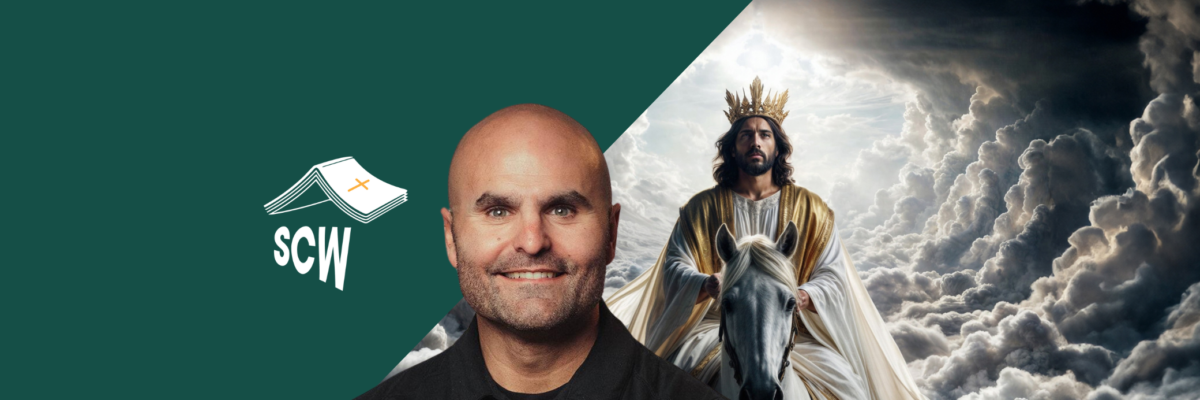
Episode 141: 18th Sunday of Ordinary Time, Year C
In today’s episode, we reflect on some details in the second reading for this upcoming 18th Sunday of Ordinary Time that are not directly related to apologetical topics but rather are indirectly related. The topics that these details give rise to are Paul’s belief in Jesus’ Messiahship and divinity, Paul’s teaching on the salvific efficacy of baptism, and Paul’s teaching on the second coming of our Lord, which in turn is related to discussions surrounding the pre-tribulation rapture doctrine that is common among some Protestants.
Readings: Click Here
Looking for Sunday Catholic Word Merchandise? Look no further! Click Here
Hey everyone,
Welcome to The Sunday Catholic Word, a podcast where we reflect on the upcoming Sunday Mass readings and pick out the details that are relevant for explaining and defending our Catholic faith.
I’m Dr. Karlo Broussard, staff apologist and speaker for Catholic Answers, and the host for this podcast.
In today’s episode, we’re going to reflect on some details in the second reading for this upcoming 18th Sunday of Ordinary Time that are not directly related to apologetical topics but rather are indirectly related. The topics that these details give rise to are Paul’s belief in Jesus’ Messiahship and divinity, Paul’s teaching on the salvific efficacy of baptism, and Paul’s teaching on the second coming of our Lord, which in turn is related to discussions surrounding the pre-tribulation rapture doctrine that is common among some Protestants.
Here’s the second reading, which is taken from Colossians 3:1-5, 9-11:
If you were raised with Christ, seek what is above,
where Christ is seated at the right hand of God.
Think of what is above, not of what is on earth.
For you have died,
and your life is hidden with Christ in God.
When Christ your life appears,
then you too will appear with him in glory.
Put to death, then, the parts of you that are earthly:
immorality, impurity, passion, evil desire,
and the greed that is idolatry.
Stop lying to one another,
since you have taken off the old self with its practices
and have put on the new self,
which is being renewed, for knowledge,
in the image of its creator.
Here there is not Greek and Jew,
circumcision and uncircumcision,
barbarian, Scythian, slave, free;
but Christ is all and in all.
The first detail that stands out for apologetical purposes is Paul’s statement, “Christ is seated at the right hand of God.” The first thing this signifies is Paul’s belief that Jesus is Messiah.
Consider that the theme of Christ sitting at the right hand of God conveys the idea of reigning with God. Now, this in turn alludes to Daniel’s vision in 7:13-14 concerning the Messianic King who will reign forever with the Ancient of Days. Daniel describes his vision as follows:
[A]nd behold, with the clouds of heaven
there came one like a son of man,
and he came to the Ancient of Days
and was presented before him.
14 And to him was given dominion
and glory and kingdom.
that all peoples, nations, and languages
should serve him;
his dominion is an everlasting dominion,
which shall not pass away,
and his kingdom one
that shall not be destroyed.
Paul is saying that Jesus is this one “like a son of man” who is given dominion to reign with the Ancient of Days forever.
The Catechism of the Catholic Church picks up on this line of exegesis in paragraph 664. It states, “Being seated at the Father’s right hand signifies the inauguration of the Messiah’s kingdom, the fulfillment of the prophet Daniel’s vision concerning the Son of man.”
Now, this allusion to the “son of man” in Daniel’s vision doesn’t only reveal Jesus was the Messiah. But I argue there is good reason to think this reveals Jesus’ divinity as well.
New Testament scholar Brant Pitre argues for this in his book The Case for Jesus: The Biblical and Historical Evidence for Christ (143-145).
Pitre highlights two details that suggest the figure’s divinity. First, Daniel describes him as “coming on the clouds.” According to the Old Testament, this is something only God does, according to Jeremiah 4:13.
Second, Daniel doesn’t say, “He is a son of man,” but he is “like a son of man.” Dr. Pitre writes, “He appears to be a merely human figure but is in fact a heavenly being” (The Case for Jesus, 144; emphasis in original).
The contemporary Jewish scholar Daniel Boyarin describes this figure as a “second divine figure” (the first being the ancient of days) and “a God who looks like a human being” (The Jewish Gospels: The Story of the Jewish Christ, 32-33).
Finally, such an exegesis of this figure in Daniel’s vision would provide a rationale as to why the high priest charged Jesus of blasphemy in Mark 14:63-64 when Jesus claimed himself to be this figure from Daniel. Recall, Jesus said to the High priest in 14:62, “[Y]ou will see the Son of man sitting at the right hand of Power, and coming with the clouds of heaven,” to which the high priest responded while tearing his clothes, “You have heard his blasphemy.”
The second detail that I want to focus on is Paul’s teaching that we as Christians have “died” and “raised with Christ.” This calls to mind his more elaborated teaching on the same theme in Romans 6:3-7, where he introduces baptism as the experience of this death and resurrection in Christ. He writes,
Do you not know that all of us who have been baptized into Christ Jesus were baptized into his death? We were buried therefore with him by baptism into death, so that as Christ was raised from the dead by the glory of the Father, we too might walk in newness of life (vv. 3-4).
Paul goes on to articulate the effects of this baptismal death and resurrection in verses 6-7:
We know that our old self was crucified with him so that the sinful body might be destroyed, and we might no longer be enslaved to sin. For he who has died is freed from sin (vv.6-7).
What’s interesting about this passage, as pointed out in Catholic circles by apologist Jimmy Akin, is that the Greek doesn’t say “freed from sin.” The Greek word translated “freed” is dikaioō, which means “to put into a right relationship (with God); acquit, declare and treat as righteous.” This is the same word Paul uses when he speaks of our justification by faith: “Since we are justified [Greek, dikaiōthentes] by faith, we have peace with God through our Lord Jesus Christ” (Rom. 5:1). So the phrase “freed from sin” in Romans 6:7 can literally be translated “justified from sin.”
Modern translations render it as “freed from sin” because the context is clearly about sanctification. For example, in the verse before Paul speaks of baptismal death, he speaks of those in Christ as having “died to sin.” As quoted above, Paul speaks of those who have died the death of baptism as “no longer enslaved to sin.”
In verses 17-18, Paul actually uses a form of the Greek word for “free” (eleutheroō) in relation to the freedom from sin that we receive in Christ:
But thanks be to God, that you who were once slaves of sin have become obedient from the heart to the standard of teaching to which you were committed, and, having been set free [Greek, eleutherōthentes] from sin, have become slaves of righteousness.
This tells us that, for Paul, justification can include sanctification, which is the interior renewal of the soul whereby the objective guilt of sin is removed. And that justification, or new birth, takes place in baptism.
In sum, Paul is teaching us here in Romans 6 that baptism saves us. And the detail from our second reading for this upcoming Sunday prompts us to reflect on this teaching.
Okay, the third and last detail that we’ll focus on for today’s episode is Paul’s teaching, “When Christ your life appears, then you too will appear with him in glory.” I do think that Paul is primarily calling our attention to the bodily resurrection at the end of time. But this theme of “appearing with him in glory” as he returns reminds me to Paul’s similar teaching in 1 Thessalonians 4:15-17, where he speaks of those Christians who are still alive at Christ’s coming will be “caught up together with [those raised from the dead] in the clouds to meet the Lord in the air” (v.17).
Some Christians view this as evidence for the pre-tribulation rapture view. But as I argue in my book Meeting the Protestant Challenge: How to Answer 50 Biblical Objections to Catholic Beliefs, this is not the case. Rather, Paul is describing how Christians will meet the Lord in the air to escort him as he returns, in a way that is analogous to the ancient custom of citizens ushering in important visitors.
It was common for citizens to meet an illustrious person (such as dignitary or victorious military leader) and his entourage outside the walls of their city and accompany him back in. This was a way for people to honor the visitor and take part in the celebration of the visitor’s coming.
We see an example of this in Acts 28:14-15, where the brethren at Rome went out of the city to meet Paul as he approached: “And so we came to Rome. And the brethren there, when they heard of us, came as far as the Forum of Appius and Three Taverns to meet us.” This ancient custom also explains why the crowds go out to meet Jesus on Palm Sunday and usher him into Jerusalem (see Matt. 21:1-17).
So, for Paul, those who are alive at the Second Coming, will join the resurrected Christians and do for our blessed Lord what the ancients did for their dignitaries: they will be caught up in the air to meet the approaching king Jesus and escort him as he “descend[s] from heaven with a cry of command” (1 Thess. 4:16).
And we know this is at the final coming of Christ at the end of time because Paul says this will happen at the time of the bodily resurrection. He writes in verse 16: “And the dead in Christ will rise first” (v.16).
We know this refers to the end of time because Paul teaches as much in 1 Corinthians 15—the end happens in tandem with the resurrection of the dead:
For as in Adam all die, so also in Christ shall all be made alive. But each in his own order: Christ the first fruits, then at his coming those who belong to Christ. Then comes the end, when he delivers the kingdom to God the Father after destroying every rule and every authority and power (1 Cor. 15:22-24).
If Paul viewed the resurrection of the dead as occurring in tandem with the end of time, and if he speaks of the resurrection of the dead in tandem with Christ’s coming in 1 Thessalonians 4:15-17, it follows that Christ’s coming in those verses is his coming at the end of time and not the beginning of a pre-tribulation rapture.
For more details, see episode 51 for the 32nd Sunday of Ordinary Time, Year A.
Conclusion
Well, my friends, that’s all I have for this episode of the Sunday Catholic Word. The second reading for this upcoming 18th Sunday of Ordinary Time, Year C provides us with some material that is at least indirectly related to apologetical topics.
• We have details that relate to Jesus’ Messiahship and divinity,
• The salvific efficacy of baptism, and
• Paul’s view of what happens at Christ’s return at the end of time.
As always, I want to thank you for subscribing to the podcast. And please be sure to tell your friends about it and invite them to subscribe as well through any podcast platform that they use. You can also access the archived episodes of the Sunday Catholic Word at sundaycatholicword.com.
You might also want to check out the other great podcasts in our Catholic Answers podcast network: Trent Horn’s The Counsel of Trent, Joe Heschmeyer’s Shameless Popery, and Jimmy Akin’s The Jimmy Akin podcast,” all of which can be found at catholic.com. And if you want to follow more of my own work, check out my website at karlobroussard.com
One last thing: if you’re interested in getting some cool mugs and stickers with my logo, “Mr. Sunday podcast,” go to shop.catholic.com.
I hope you have a blessed 18th Sunday of Ordinary Time, Year C. Until next time, God Bless.



